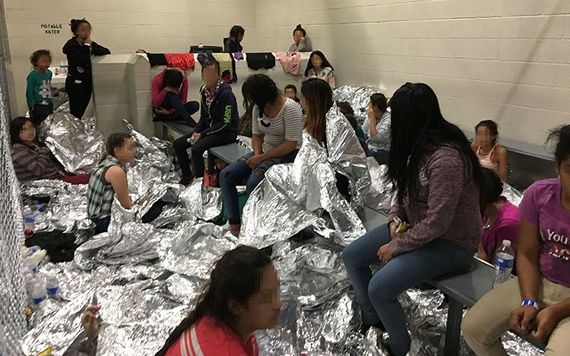Action is needed. "At what stage is it reasonable for developed countries to decide to limit immigration to preserve their own culture, values, and societal norms?"
The picture of the bodies of Oscar Ramirez and his little daughter Valeria face down in the Rio Grande last week elicited huge sympathy here in Ireland, as it did around the world. And of course, this sympathy was understandable. What had happened was heartbreaking.
But sympathy alone is never going to solve the migrant problem, either in the U.S. or Europe.
As well as sympathy here, there was the usual knee-jerk outrage at the U.S. and President Trump in particular, although why the president is to blame for this tragedy was not made clear.
Yes, immigration under Trump has been tightened, and at the same time, the numbers trying to get into the U.S. across its southern border have soared in recent months. Together, this has meant the U.S. immigration system is under severe pressure.
But does that make Trump directly culpable for this tragedy?
Read more: This July 4th it does not feel so good to be an American
As far as we know both Ramirez and his wife (she survived the attempt to cross the river) were poor but not destitute. Both had jobs in El Salvador and a relatively comfortable home by local standards. (We know this because we saw the house when Ramirez’s mother was interviewed on TV.)
Nor was it being claimed that they were under any immediate threat from the gang violence in the San Martin district of the capital San Salvador where they lived. The gangs make life in El Salvador difficult and there are regular killings.
But the main reason some 500 people left the San Martin district for the U.S. last year, according to the local mayor, is lack of jobs and poverty. Ramirez had a dream of a better life in America, a desire so strong he was unwilling to wait and go through the legal channels.
When he and his wife and child eventually arrived at the bridge in northern Mexico the border crossing was closed. So he took a terrible chance with his daughter's life and they both paid the price.
Maybe he felt that going through the legal channels was too slow and likely to be hopeless. Maybe he felt it was likely he would be classed as an economic migrant rather than a refugee and an asylum application would be rejected before he could even get into the U.S. Maybe he believed, as many of the migrants at the southern border do, that if he could get inside the U.S. with his child he would have a far better chance of entering the process and eventually being allowed to stay.
Whatever the reason, this awful tragedy was the result. But it was a tragic miscalculation on Ramirez’s part. The terrible risk he took in the Rio Grande was the direct cause, not anything that Trump has done.
The expressions of outrage here ignored this and also that Ramirez, based on what we know to date, was clearly an economic migrant rather than a refugee. No one can blame him for wanting to do better than the low paying job he had in a pizza shop in San Martin. But there are tens of millions more just like him in Central America.
Is the U.S. supposed to open its southern border and let them all in? Who is to blame if a migrant and his daughter die in the attempt to circumvent immigration rules by crossing a dangerous river?

A crammed cell in a detention center in Texas.
Some of the commentary in Ireland (and elsewhere) drew attention to the similarity between the Rio Grande picture and that of Alan Kurdi, the little Syrian boy whose body was found face down in the water on the Turkish shore in 2015 after a failed attempt to cross a few miles of sea to Greece. That heart-rending image caused a global outcry.
But there is another side to that story as well. Questions were also raised then about that father's decision to leave the safety of Turkey and undertake such a dangerous sea crossing in an over-crowded inflatable boat with his little son to try to get into the EU.
As is usual with stories about migration, commentary here on the Rio Grande tragedy was accompanied by reminders of the Irish history of migration to the U.S. The point was made that the huge wave of Irish migration in the 19th century after the Famine was of people fleeing starvation and destitution here. They were the economic migrants of the time -- and they were let into the U.S. even though they had no papers, as were migrants from many other parts of the world.
That is true, of course, but the equivalence is false. America, as we know, is a country built by immigration and it was in that expansionary phase at the time. Undocumented migrants (to use the current phrase) were the norm and continued to be up to 1920s when restrictions began to be applied. As time went on and the need for migrants and the ability to absorb them lessened, the rules and requirements for gaining entry to the U.S. increased, just as they did elsewhere in the developed world.
The effort by Trump critics here to guilt trip the Irish today on incidents like the Ramirez tragedy because of our history of migration is fatuous.
Less than convincing also were some of the expressions of horror elsewhere in Europe at the tragic death of little Valerie and her father in the waters of the Rio Grande. In the past year, Europe has increased efforts to stem the flow of migrants across the Mediterranean from North Africa and Turkey, mainly by withdrawing or curtailing rescue ships. One result is that an average of six migrants a day drowned in the waters of the Med in 2018, or well over 2,000 for the year. `
As you know, there have been deaths among migrants attempting to cross the U.S. southern border but nothing on this scale. And it is continuing -- the UN estimates that so far this year over 400 migrants have drowned in the Med.
The Rio Grande tragedy was not the only migration incident to make the news here. Last week saw another confrontation in Europe when a migrant rescue ship, the Sea-Watch 3, which is run by a German charity, landed over 40 migrants on the Italian island of Lampedusa after a two-week stand-off with the Italian authorities.
The migrants had been picked up from a sinking boat off the coast of Libya, and as usual, the majority were men and from sub-Saharan Africa rather than conflict zones in North Africa -- so it is safe to assume most are economic migrants. Italy, which has now closed its doors to migrants, has only taken them on the understanding that they will be distributed among other EU countries.
None of this is to suggest that what either the U.S. or the EU is doing to control migration is wrong. There cannot be an open doors policy on either side of the Atlantic because voters simply won't accept that, even though the majority still seems to be willing to help in cases where migrants are genuinely fleeing for their lives.
Even in these cases, however, there is a growing expectation that such migrants should stay in the first safe country they arrive in, rather than insisting on a right to go to whatever country they choose and bending the rules to get there.
Part of the problem is the difficulty in distinguishing between refugees fleeing real danger and economic migrants who simply want a better life.
The solution to all this both in the U.S. and the EU has to be the encouragement of development and lawful society in the countries which migrants are leaving. As this column has advocated before, what is needed in Central America is a modern day equivalent of the Marshall Plan with which the U.S. helped Europe recover after World War II.
A similar plan funded by Europe is needed to develop the worst parts of Africa. But of course, this is easier said than done.
Local corruption and incompetence would make such moves difficult to implement. Even so, the eventual solution to the migration problem has to lie at the source rather than at the borders of the U.S. or Europe.
On other levels, the whole question of migration raises a number of fundamental questions which will face developed countries into the future. The internet and the availability of cell phones even in the poorest countries mean that people who live in places like Central America or the Congo can see the lifestyle available in the U.S. or Europe and want to be part of it.
For that reason alone, migration is certain to be an ongoing phenomenon into the future and people will try to find their way around rules and regulations to get where they want to be. We're into a new era in which the factors causing migration will not be as simple as they were in previous centuries when war and famine were the main drivers.
At what stage is it reasonable for developed countries to decide to limit immigration to preserve their own culture, values, and societal norms? The pace of immigration into Ireland, for example, has been extraordinary, going from close to zero 50 years ago to the present situation in which we have a non-Irish born population of over 17 percent, according to the 2016 census.
That speed of immigration far exceeds anything that has happened in the U.S. So far this has not caused too many problems here, although public services like schools have been feeling the pressure.
In the main, however, we have handled this well, and so far we have not seen the rise of the kind of anti-immigrant political parties that have emerged elsewhere in Europe. Most immigrants here have ended up in cities, particularly the greater Dublin area, and they are spread out enough to avoid creating ghettoes.
Even so, in towns like Balbriggan, Rush and Lusk on the north side of Dublin which have grown into huge new suburbs of the capital with cheaper housing, the size of the immigrant communities is striking. And it's not just in Dublin or our other cities.
Immigrants are now a significant part of many larger towns across rural Ireland, with some extreme examples shown up in the census. Almost 40 percent of the over 2,383 population of Ballyhaunis in Co. Mayo, for example, are non-Irish born. Four other towns have non-Irish born populations of more than 30 percent -- Edgeworthstown and Ballymahon in Longford, Ballyjamesduff in Cavan and Monaghan Town, a report in The Irish Times pointed out last week.
These are quiet, rural and even somewhat remote places, not the kind of locations where you might expect to find large numbers of immigrants. But it is happening, and whatever is claimed about the benefits of multi-culturalism, it will change Ireland as we go on into the future.
Whether everyone here will be happy about that remains to be seen.
Read more: Think your ancestors came here legally and 'waited their turn'? Think again




Comments